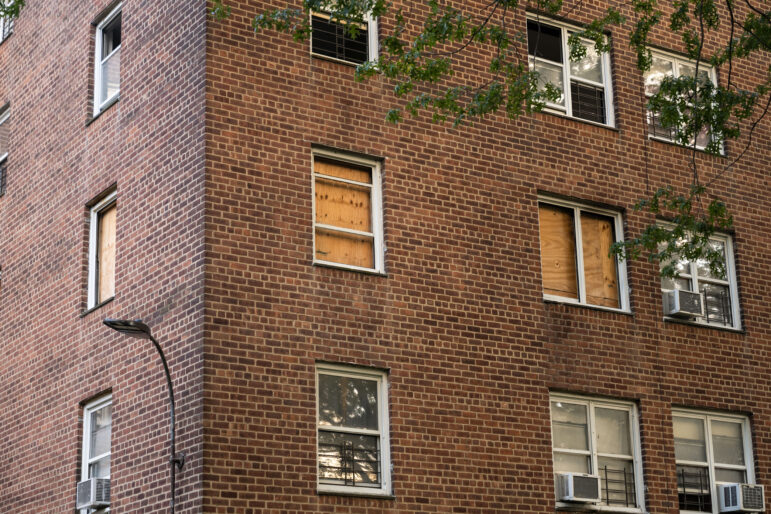City Limits on Thursday hosted a panel conversation about the plans being pitched to drum up funding for the city’s public housing system. What is RAD/PACT and the new Preservation Trust, how do they differ from traditional Section 9, and what does each option mean for tenants?

Scott Heins
A building at NYCHA’s Nostrand Houses, where residents will be the first to vote this month on what funding model they want for their homes.Next year, the New York City Housing Authority (NYCHA) turns 90—and for the last several decades, it hasn’t been faring so well.
“In the 90s, we started to see a real deterioration,” Brian Honan, NYCHA’s vice president of the office of intergovernmental relations, said during a City Limits’ panel discussion Thursday about the future of New York’s public housing, moderated by reporter Tatyana Turner.
At the time, Honan described, the city, state and federal governments all began to disinvest in NYCHA, underfunding that’s fed the deterioration of its buildings, which are now around 70 years old on average.
“Think of it as a person who’s about 70, who didn’t really take care of themselves all that well, and never went to the doctor,” Honan said. “70 is not all that old for a person, but if you didn’t take care of yourself, you’re going to have serious health issues. And many of our developments do have serious health issues.”
How to get the funding to address those health issues—which by NYCHA’s assessment amounts to $78.3 billion in capital repair needs over the next 20 years—is the subject of much current debate, and at the heart of a vote taking place at Brooklyn’s Nostrand Houses this month.
Tenants are being asked to choose what funding model the Sheepshead Bay campus will pursue. They can remain in Section 9, the federal public housing program, or convert to more lucrative federally-funded subsidies under Section 8 by way of NYCHA’s RAD/PACT or Preservation Trust initiatives. Votes at other developments are expected to take place next year.
Related Reading: Voting on NYCHA’s Future [VIDEO]
PACT, or the Permanent Affordability Commitment Together, has been underway since 2015 and brings in private developers to manage the day-to-day operations at NYCHA campuses. Under the Preservation Trust, developments remain under NYCHA management but are transferred to the Trust, a recently formed public benefit corporation. Both models are intended to unlock additional capital repair money, including through the issuance of bonds, that can’t be accessed under traditional Section 9.
“Most of the rights traditional of Section 9 do transfer to Section 8—tenants cannot be charged more than 30 percent of their income as rent, some succession rights, some grievance rights, etc., but there are some things that do change,” said panelist Luis Henriquez Carrero, director of litigation at Manhattan Legal Services, where he represents NYCHA tenants.
One of those changes is in how transfer requests are handled: While Section 9 NYCHA residents can request moves to any other Section 9 development, the same does not apply to Section 8 tenants, who have a smaller universe of NYCHA apartments to potentially transfer to.
“We have had tenants—clients that are disabled tenants, clients who are [domestic violence] survivors—that have been told, ‘You can no longer transfer to another public housing development. Here’s a portable voucher, a Section 8 voucher, go look for housing yourself in the private market,'” Henriquez Carrero said.
Fellow panelist Aixa Torres, resident association president at NYCHA’s Smith Houses, cited such differences as behind her own distrust of both the Trust and PACT programs.
“There are real protections under the Section 9 [program] and in the process that are not either in the Trust or in the RAD,” said Torres, who sits on NYCHA’s Citywide Council of Presidents and is a member of the group Residents to Preserve Public Housing (RPPH). She called for residents to play a direct role in management.
“I firmly believe that public housing residents have the know-how and the skills and the education necessary—or [are] able to learn, if we don’t know—to run our own development. And that’s where we would go. And that can only be done under Section 9,” Torres said during Thursday’s discussion.
By contrast, panelist and Nostrand Houses Resident Association President Barbara McFadden has put her support behind the Trust (she’s also a member of the public entity’s nine-member board).
“If we don’t fix our developments, it’s going to collapse. And I’m not going to wait for the walls to come crumbling down,” McFadden said. “You have to try something different. I do believe change is for the better.”
Voting at the Nostrand Houses, which is being run by an outside company, will continue through Dec. 7. Whatever option tenants chose, panelist and attorney Anna Luft said, NYCHA will need to also address a history of mismanagement at the housing authority which has contributed to its deterioration, alongside the more obvious funding gaps.
“No matter which regulatory scheme any development ends up with—Trust, PACT, or Section 9—I think it’s really important for tenants to have the ability to hold whichever management company is there, or the development, accountable,” said Luft, a supervising attorney and director of the Public Housing Justice Project at the New York Legal Assistance Group (NYLAG).
You can watch the full panel discussion—which touches on, among other topics, how NYCHA will handle relocations during construction—in the video below.








